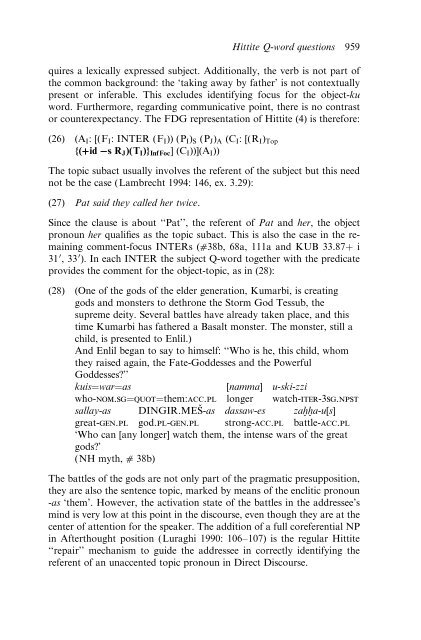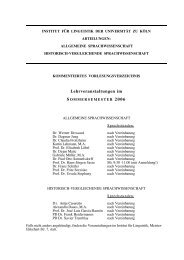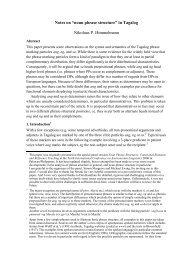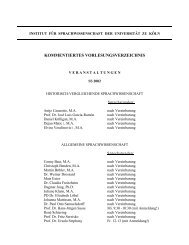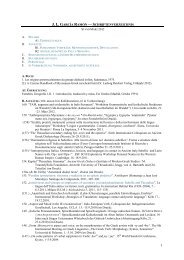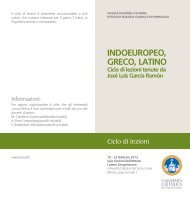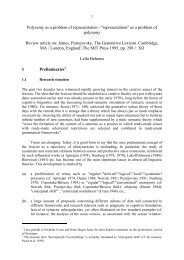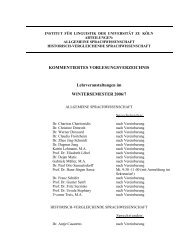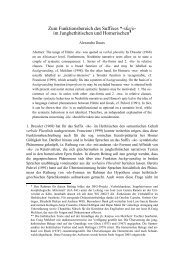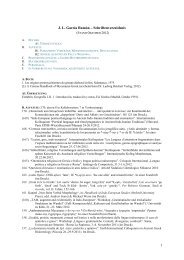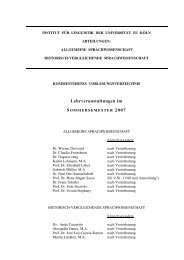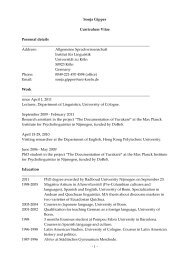Topics in Anatolian Historical Grammar Prof. Dr. H. Craig Melchert
Topics in Anatolian Historical Grammar Prof. Dr. H. Craig Melchert
Topics in Anatolian Historical Grammar Prof. Dr. H. Craig Melchert
You also want an ePaper? Increase the reach of your titles
YUMPU automatically turns print PDFs into web optimized ePapers that Google loves.
quires a lexically expressed subject. Additionally, the verb is not part of<br />
the common background: the ‘tak<strong>in</strong>g away by father’ is not contextually<br />
present or <strong>in</strong>ferable. This excludes identify<strong>in</strong>g focus for the object-ku<br />
word. Furthermore, regard<strong>in</strong>g communicative po<strong>in</strong>t, there is no contrast<br />
or counterexpectancy. The FDG representation of Hittite (4) is therefore:<br />
(26) (A I :[(F I : INTER (F I )) (P I ) S (P J ) A (C I :[(R I ) Top<br />
{(Bid Cs R J )(T I )} InfFoc ](C I ))](A I ))<br />
The topic subact usually <strong>in</strong>volves the referent of the subject but this need<br />
not be the case (Lambrecht 1994: 146, ex. 3.29):<br />
(27) Pat said they called her twice.<br />
Hittite Q-word questions 959<br />
S<strong>in</strong>ce the clause is about ‘‘Pat’’, the referent of Pat and her, the object<br />
pronoun her qualifies as the topic subact. This is also the case <strong>in</strong> the rema<strong>in</strong><strong>in</strong>g<br />
comment-focus INTERs (a38b, 68a, 111a and KUB 33.87þ i<br />
31 0 ,33 0 ). In each INTER the subject Q-word together with the predicate<br />
provides the comment for the object-topic, as <strong>in</strong> (28):<br />
(28) (One of the gods of the elder generation, Kumarbi, is creat<strong>in</strong>g<br />
gods and monsters to dethrone the Storm God Tessub, the<br />
supreme deity. Several battles have already taken place, and this<br />
time Kumarbi has fathered a Basalt monster. The monster, still a<br />
child, is presented to Enlil.)<br />
And Enlil began to say to himself: ‘‘Who is he, this child, whom<br />
they raised aga<strong>in</strong>, the Fate-Goddesses and the Powerful<br />
Goddesses?’’<br />
kuis¼war¼as [namma] u-ski-zzi<br />
who-nom.sg¼quot¼them:acc.pl longer watch-iter-3sg.npst<br />
sallay-as DINGIR.MEŠ-as dassaw-es zah˘ h˘ a-u[s]<br />
great-gen.pl god.pl-gen.pl strong-acc.pl battle-acc.pl<br />
‘Who can [any longer] watch them, the <strong>in</strong>tense wars of the great<br />
gods?’<br />
(NH myth, a 38b)<br />
The battles of the gods are not only part of the pragmatic presupposition,<br />
they are also the sentence topic, marked by means of the enclitic pronoun<br />
-as ‘them’. However, the activation state of the battles <strong>in</strong> the addressee’s<br />
m<strong>in</strong>d is very low at this po<strong>in</strong>t <strong>in</strong> the discourse, even though they are at the<br />
center of attention for the speaker. The addition of a full coreferential NP<br />
<strong>in</strong> Afterthought position (Luraghi 1990: 106–107) is the regular Hittite<br />
‘‘repair’’ mechanism to guide the addressee <strong>in</strong> correctly identify<strong>in</strong>g the<br />
referent of an unaccented topic pronoun <strong>in</strong> Direct Discourse.


